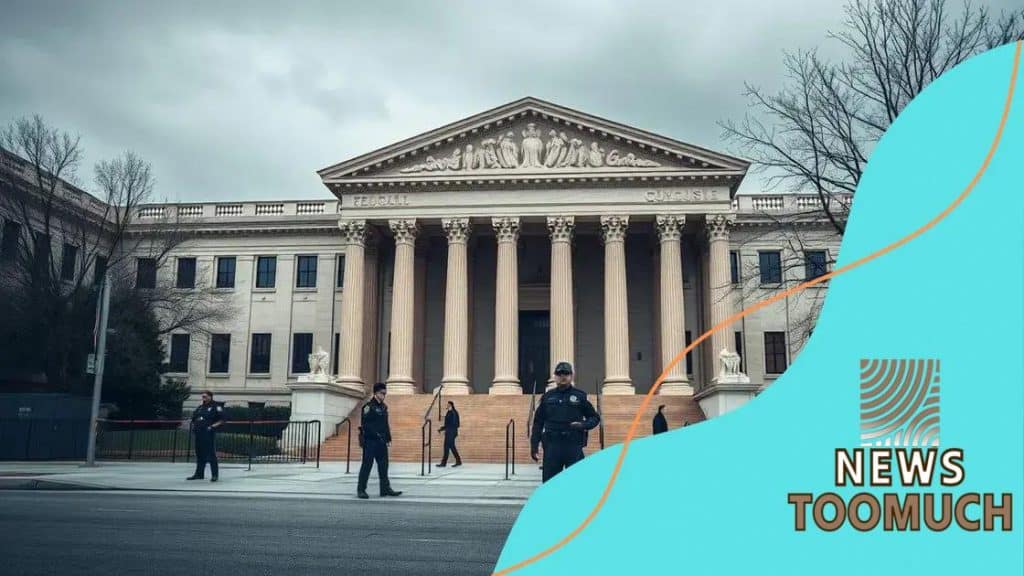Domestic threats and federal judiciary security concerns

Domestic threats and federal judiciary security involve multiple risks. These include organized crime and political extremism.
Federal agencies must implement robust protection measures. Their goal is to ensure judicial independence and public trust.
Protecting courts and judges is essential. Security ensures the legal system remains fair and credible.
Understanding domestic threats to judiciary security
Understanding Domestic threats to the judiciary is crucial. Threats can arise from different sources.
These risks can significantly impact judicial processes. Recognizing them helps in planning effective safeguards.
Awareness of threats informs federal policies. It is key to maintaining the integrity of the legal system.
Types of Domestic Threats
The judiciary faces threats from multiple angles. Organized crime, political extremism, or personal vendettas are common.
Each threat category presents unique challenges. Measures must be tailored to the type of risk.
Addressing all threats protects judges. It also maintains public confidence in courts.
Impact on Legal Proceedings
Domestic threats can delay cases and affect rulings. Judges may worry about personal or family safety.
This can create a ripple effect within the legal system. Justice may be slowed or influenced indirectly.
Providing judges with resources ensures safer proceedings. Proper support preserves fair trials.
Historical examples of threats against the judiciary
Historical incidents show the judiciary’s vulnerability. Judges have faced both attacks and political pressures.
Examples include assassinations and targeted harassment. Such events disrupt normal judicial functioning.
Learning from history informs modern protections. Understanding past threats is essential for prevention.
Notable Historical Incidents
Several key events highlight the risks faced by judges and courts. This includes attacks on judges, as well as political interference in legal proceedings.
- The assassination of Judge John H. McCloy in 1971.
- Political threats to the Supreme Court in response to controversial rulings.
- Harassment of jurors and judges during high-profile cases.
These examples illustrate the complexity of maintaining judicial independence. When judges are under threat, it can distort the public’s perception of justice.
The consequences may extend beyond individual cases and challenge the very foundation of the legal system.
The Long-term Impacts
Domestic threats create an environment of fear for judges. This can influence decisions and overall justice.
Intimidation may lead to biased rulings. It also erodes public confidence in legal outcomes.
Protecting the judiciary ensures long-term stability. Safety measures strengthen judicial independence.
The role of federal agencies in safeguarding judges

Federal agencies are critical to judicial security. They work to protect judges from multiple threats.
Their responsibilities include monitoring, security details, and training. Judges receive guidance on safety protocols.
Collaboration among agencies creates a safer environment. This allows judges to make impartial decisions confidently.
Key Agencies Involved
The U.S. Marshals Service protects judges and families. The FBI investigates threats to the judiciary.
The Department of Homeland Security works with local authorities. They improve security at courthouses nationwide.
Combined efforts create a robust safety network. Judges can operate without fear or undue influence.
Collaborative Efforts
Federal agencies also focus on emergency preparedness. Protocols ensure judges know what to do in crises.
Training sessions teach risk mitigation strategies. Judges learn to handle threats calmly and effectively.
Local law enforcement partnerships enhance security. Cooperation strengthens the judiciary’s protection framework.
Challenges faced by the federal judiciary
The federal judiciary faces numerous challenges. These can affect efficiency and independence.
One major challenge is workload. Judges handle growing numbers of cases, causing delays.
Domestic threats to judicial independence are another concern. External pressures can influence decisions or public perception.
Increasing Workload
Rising case numbers strain judges. Limited resources may compromise thorough review of cases.
Pressure to resolve cases quickly adds stress. Judges may struggle to balance speed and accuracy.
Workload challenges highlight the need for support. Efficient management ensures fair justice for all parties.
Threats to Independence
Judges face growing external pressures. Political or social influences can compromise impartiality.
Public perception also matters. If judges appear biased, confidence in the legal system declines.
Protecting independence ensures credible rulings. Safeguards allow judges to perform their duties without interference.
Legislation addressing judiciary security
Legislation plays a key role in protecting judges. Laws establish security measures and allocate resources.
The Judicial Security Improvement Act funds courthouse safety upgrades. Other acts support victims and court staff.
These laws strengthen judicial safety. They also promote confidence in legal proceedings.
Key Legislation
Several key pieces of legislation enhance judiciary safety. They provide protections and allocate resources.
These laws focus on ensuring judges and court staff remain secure. Robust legal frameworks help manage potential risks.
Judicial security is strengthened through structured legal measures. This prepares the judiciary for emerging threats effectively.
Impact of Legislation
Legislation reassures the public about judicial safety. Judges can operate without fear of retaliation.
Continuous evaluation ensures laws remain effective. Adjustments address new threats as they arise.
Robust legal frameworks are essential. They maintain the integrity of the judiciary over time.
Future implications for judiciary safety

Emerging threats require proactive planning. Judges and staff must be prepared for evolving risks.
Technology both aids and threatens security. Cyber threats and surveillance challenges must be addressed.
Societal changes also impact safety. Growing polarization may increase hostility toward judges.
Technological Advancements
New technology enhances courtroom security. Body cameras and monitoring systems provide additional protection.
Cybersecurity risks must also be mitigated. Sensitive information requires robust online safeguards.
Federal agencies must adapt continuously. Technology offers tools but introduces new challenges.
Changing Societal Perspectives
Public opinion can impact judicial safety. Polarization may increase hostility toward judges and decisions.
Judges face scrutiny that can affect decision-making. Security and public confidence are essential to maintain independence.
A secure environment enables impartial rulings. Legislative and societal support reinforce judicial effectiveness.
Conclusion
Addressing future judiciary safety requires legislative support and proactive measures. Public education is also essential.
Investing in security technology and preparedness protects judges. Both physical and cyber threats must be mitigated.
These combined efforts ensure justice is served fairly. Judicial independence and public confidence are maintained.
FAQ – Frequently Asked Questions about Domestic Threats and Federal Judiciary Security
What are the main threats to federal judges?
Federal judges face threats from organized crime, political extremism, and individual harassment, which can impact their safety and the judicial process.
How do federal agencies protect judges?
Federal agencies such as the U.S. Marshals Service and the FBI provide security details and investigate threats against judges to ensure their safety.
What laws support judiciary security?
Key legislation like the Judicial Security Improvement Act and the Court Security Improvement Act are designed to enhance the safety and resources for judges.
Why is public confidence important for the judiciary?
Public confidence is crucial as it ensures that people trust the judicial system and the decisions made by judges, which is essential for maintaining justice.





